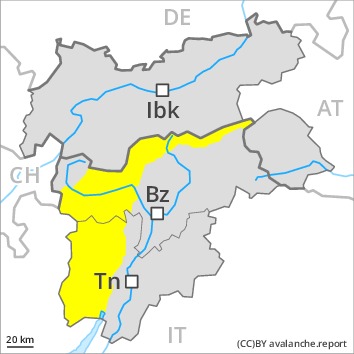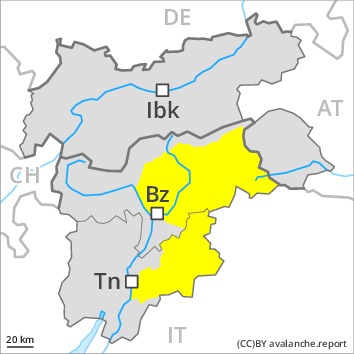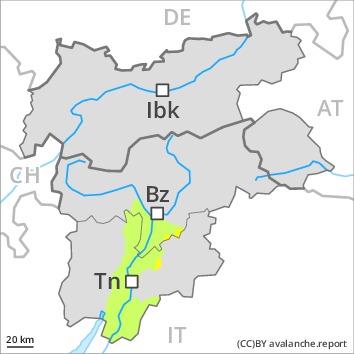
Danger level
 | 2200m
|
Avalanche Problem
 | | Wind-drifted snow |
|  | |  |
 | | Gliding snow |
|  | |  |

Wind slabs and weakly bonded old snow require caution. In addition further individual gliding avalanches are possible.
The more recent wind slabs can be released in isolated cases on steep shady slopes above approximately 2200 m. The avalanche prone locations are to be found adjacent to ridgelines and in gullies and bowls.
Avalanche prone weak layers exist deeper in the snowpack on steep shady slopes. Avalanches can in some places be released by people and reach large size. The prevalence of avalanche prone locations and likelihood of triggering will increase with altitude. Caution is to be exercised at transitions from a shallow to a deep snowpack.
On very steep grassy slopes and on sunny slopes more gliding avalanches are possible, even quite large ones. Areas with glide cracks are to be avoided.
Snowpack
dp.6: cold, loose snow and wind
dp.2: gliding snow
In some regions 5 to 10 cm of snow, and even more in some localities, will fall. As a consequence of a strong to storm force northwesterly wind, mostly small wind slabs will form. In some places wind slabs are lying on a weakly bonded old snowpack, especially on shady slopes. In its middle, the snowpack is well consolidated. High altitudes and the high Alpine regions: Towards its base, the snowpack is faceted and weak.
Tendency
The avalanche danger will persist.

Danger level
 | 2200m
|
Avalanche Problem
 | | Wind-drifted snow |
|  | |  |
 | | Gliding snow |
|  | |  |

Fresh wind slabs require caution. Caution is to be exercised in areas with glide cracks.
The more recent wind slabs can be released in isolated cases on steep shady slopes above approximately 2200 m. Mostly avalanches are only small but can be released also by a single winter sport participant. The avalanche prone locations are to be found adjacent to ridgelines and in gullies and bowls. The prevalence of avalanche prone locations and likelihood of triggering will increase with altitude.
On very steep grassy slopes and on sunny slopes more gliding avalanches are possible, even quite large ones. Areas with glide cracks are to be avoided.
Snowpack
dp.6: cold, loose snow and wind
dp.2: gliding snow
As a consequence of a strong to storm force wind from westerly directions, mostly small wind slabs will form. In some places wind slabs are lying on the soft surface of an old snowpack, especially on shady slopes. In its middle, the snowpack is well consolidated. Towards its base, the snowpack is faceted, especially on shady slopes above the tree line, as well as on sunny slopes in high Alpine regions.
Tendency
The avalanche danger will persist.

Danger level
 | 2200m
|
Avalanche Problem

Fresh wind slabs require caution.
The more recent wind slabs can be released easily in some places above approximately 2200 m. This applies in particular adjacent to ridgelines and in gullies and bowls.
On very steep grassy slopes and on sunny slopes only isolated gliding avalanches are possible.
Snowpack
dp.6: cold, loose snow and wind
Some snow will fall. As a consequence of a sometimes strong northwesterly wind, rather small wind slabs will form. In some places wind slabs are lying on a weakly bonded old snowpack, especially on shady slopes.
In its middle, the snowpack is well consolidated. Towards its base, the snowpack is faceted.
At low and intermediate altitudes only a little snow is lying.
Tendency
The avalanche danger will persist.

Danger level
 | 2200m
|
Avalanche Problem
 | | Persistent weak layer |
|  | |  |
 | | Wind-drifted snow |
|  | |  |

Wind slabs and weakly bonded old snow require caution.
Avalanche prone weak layers exist deeper in the snowpack on steep shady slopes. Avalanches can be triggered in the faceted old snow and reach large size in some cases. Such avalanche prone locations are rather rare but are difficult to recognise. Caution is to be exercised at transitions from a shallow to a deep snowpack.
The more recent wind slabs can be released in isolated cases on steep shady slopes above approximately 2200 m. The avalanche prone locations are to be found adjacent to ridgelines and in gullies and bowls. The prevalence of avalanche prone locations and likelihood of triggering will increase with altitude.
Snowpack
dp.1: deep persistent weak layer
dp.6: cold, loose snow and wind
In some regions 5 to 10 cm of snow, and even more in some localities, will fall. As a consequence of a strong to storm force northwesterly wind, mostly small wind slabs will form. In some places wind slabs are lying on the soft surface of an old snowpack, especially on shady slopes.
High altitudes and the high Alpine regions: Towards its base, the snowpack is faceted and weak.
Tendency
The avalanche danger will persist.














